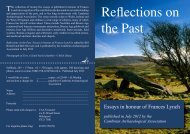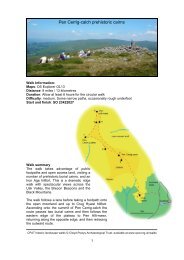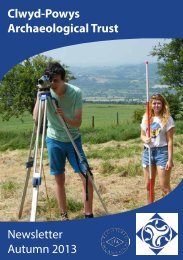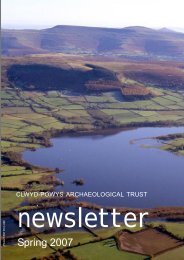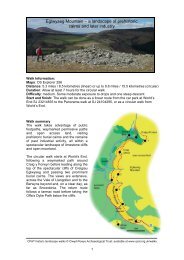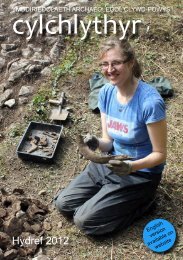Datganiad Cadwraeth Clawdd Offa Offa's Dyke Conservation ...
Datganiad Cadwraeth Clawdd Offa Offa's Dyke Conservation ...
Datganiad Cadwraeth Clawdd Offa Offa's Dyke Conservation ...
Create successful ePaper yourself
Turn your PDF publications into a flip-book with our unique Google optimized e-Paper software.
21 <strong>Datganiad</strong> <strong>Cadwraeth</strong> <strong>Clawdd</strong> <strong>Offa</strong><strong>Offa</strong>'s <strong>Dyke</strong> <strong>Conservation</strong> Statement 21Yn wir, un posibilrwydd diddorol yw bod presenoldeb yclawdd ei hunan wedi cael dylanwad uniongyrchol ar dwfhunaniaeth genedlaethol Gymreig yn y canrifoedd ar ôl <strong>Offa</strong>.Efallai fod y llinell artiffisial a roddwyd ar y dirwedd gan yclawdd wedi codi i bwysigrwydd symbolaidd yn gyflym feldatganiad grymus o’r gwahaniaeth ymddangosiadol rhwngpopeth i’r gorllewin o Brydain ‘Seisnig’. Yn y modd hwn, efallaiy bu i Glawdd <strong>Offa</strong> helpu creu syniad newydd o uniaddiwylliannol cyffredin ymhlith pobl a ddaeth i gael eu galw —ac i feddwl amdanynt eu hunain — fel Cymry.3.16 Yr hyn sy’n sicr wedi ei gadarnhau yn hanesyddol ywbod <strong>Clawdd</strong> <strong>Offa</strong> ers amser maith wedi ei weld a’i ddeall fel ffinsymbolaidd bwysig. Mae cofnod yn y Rholiau Patent ym 1233mewn perthynas â Llanffynhonwen yn Swydd Amwythig yngwahaniaethu rhwng gw~r yn byw ‘this side of Offediche’ a’rrhai i’r gorllewin (dyfynnwyd gan Noble, 1983, tudalen 76), acroedd y clawdd weithiau yn llinell wahanu ddiwylliannolbendant yn y dirwedd ganoloesol. Un enghraifft yw ardal Clun,lle roedd y clawdd, erbyn cyfnod y Normaniaid, yn gwasanaethufel ffin rhan ‘Temsed’ Arglwyddiaeth Clun lle’r ymgartrefoddnifer sylweddol o drigolion Cymreig. Pan ddynodwyd rhannauo’r clawdd yn ffin rhwng Cymru a Lloegr yn swyddogol yn y16eg ganrif, efallai nad oedd hyn yn ddim mwy na chydnabod yndiriogaethol rôl roedd yr henebyn, mewn termau diwylliannol asymbolaidd, wedi ei chyflawni ers amser maith.significance. Indeed, one intriguing possibility is that the verypresence of the monument had a direct influence on theemergence of the Welsh national identity in the centuries after<strong>Offa</strong>. The artificial line which the dyke indelibly marked on thelandscape may have quickly gained symbolic importance as apowerful statement of the apparent separation of all to thewest from perceived ‘English’ Britain. In this way <strong>Offa</strong>’s <strong>Dyke</strong>perhaps helped to create a novel sense of common culturalunity among peoples who came to be called and to think ofthemselves as Welsh.3.16 What is certainly well established historically is that<strong>Offa</strong>’s <strong>Dyke</strong> has long been seen and understood as animportant symbolic boundary. An entry in the Patent Rollsof 1233 relating to Chirbury in Shropshire pointedlydistinguishes men living ‘this side of Offediche’ from thoseto the west (quoted in Noble 1983, page 76), and the dykewas sometimes an explicit cultural dividing line in themedieval landscape. One example is the Clun area, where bythe Norman period the dyke served as the border of theTemsed part of the Clun Lordship which was substantiallysettled by incoming Welsh inhabitants. The officialdesignation of sections of the dyke as the English/Welshborder in the 16th century perhaps did no more thanterritorially recognise a role which, in cultural and symbolicterms, the monument had long fulfilled.Y clawdd yn y dirwedd esblygiadol3.17 Mae perthynas ffisegol y clawdd yn y dirweddhanesyddol yn adrodd stori ddifyr yngl~n â datblygiadymarferol y gwrthglawdd dros y canrifoedd. Bellach, hon yw’rnodwedd weledol hynaf yn aml yn y dirwedd.3.18 Ail-ddefnyddiwyd yr henebyn yn aml mewncyfnodau diweddarach, boed fel elfen o amddiffynfeydd trefganoloesol Trefyclo, fel torlan amddiffyn rhag llifogydd arorlifdir afon Hafren, neu fel llwybr lôn neu ffordd. Mewnproses ddinistriol mwy uniongyrchol, a ddechreuodd ynfuan ar ôl adeiladu’r clawdd, mae llawer o rannau o’r clawddwedi eu gostwng trwy gyfuniad o lefelu bwriadol ac aredigdro ar ôl tro. Yn arbennig yn yr ardaloedd iseldiroeddamaethyddol, lle mae erydiad wedi bod waethaf, mae’rnewidiadau yng nghadwraeth y clawdd o un cae i’r nesafynddynt eu hunain yn gofnod gwerthfawr o’r newidiadauyn y dirwedd (Everson 1991).3.19 Er gwaethaf y ffaith nad yw’r clawdd i’w weld mewn rhaimannau, yr hyn sy’n amlwg bron bob amser ym mhatrwm ysystemau caeau ac aneddiadau gerllaw yw’r graddau yr oedd ygwrthglawdd yn parhau i fod yn nodwedd strwythurollywodraethol, gyda’r dirwedd ganoloesol a’r dirweddddiweddarach leol yn cael ei threfnu o’i amgylch.The dyke in the evolving landscape3.17 The physical relationship of the dyke to the historiclandscape in which it is now often the oldest visible featuretells a fascinating story about the practical evolution of theearthwork over the centuries.3.18 The monument was often re-used in later times, whetheras an element of the medieval town defences of Knighton, as aflood protection bank on the Severn flood plain, or morehumbly as the route of a lane or road. In a more directlydestructive process which must have begun soon after it wasfirst built, many sections of the dyke have been reduced by acombination of deliberate levelling and subsequent repeatedploughing. Particularly in the agriculturally favoured lowlandareas, where erosion has been greatest, the changes inpreservation of the dyke from one field to the next are inthemselves a valuable record of the sequence of landscapechange (Everson 1991).3.19 Despite the removal of the dyke in some places, what isnearly always apparent in the patterning of field systems andsettlement adjacent to it is the extent to which the earthworkcontinued to be the dominant structural feature around whichthe local medieval and later landscape was organised.



